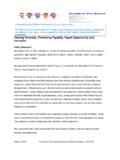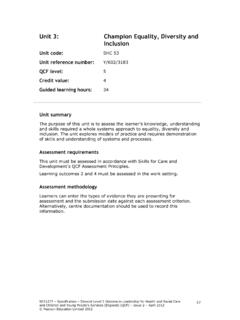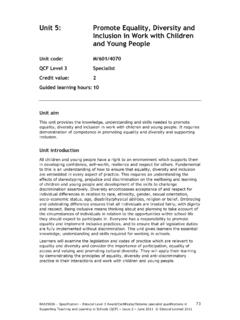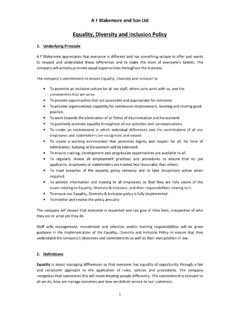Transcription of TDA 2.4 Equality, diversity & inclusion in work with ...
1 53 This unit focuses on the importance of promoting equality and diversity in all aspects of work with children and young people. You will explore how prejudice and discrimination impacts on individuals and groups in a school setting and ways that you can support policies and procedures to break down barriers. By the end of this unit you will: understand the importance of promoting equality and diversity in work with children and young people understand the impact of prejudice and discrimination on children and young people understand inclusion and inclusive practices in work with children and young equality , diversity & inclusion in work with children & young people54 Level 2 Certifi cate Supporting Teaching & Learning in SchoolsUnderstand the importance of promoting equality and diversity in work with children and young peopleIdentify the current legislation and codes of practice relevant to the promotion of equality and valuing of diversityEach school must produce a range of policies which formally set out the guidelines and procedures for ensuring equality .
2 These must take account of the rights of all individuals and groups within the school. When considering the way policies work to ensure equality and inclusion , we o en just think of the teaching and learning that is happening in the classroom. Policies must also pay regard to the values and practice which are part of all aspects of school life. Before exploring the policies in your own school, it is helpful to gain an understanding of relevant legislation and its purpose. You do not need detailed knowledge of each one, but it is important to understand the legal duties of the school. This will help you to understand your own role and responsibility to adhere to legislation and rights of all children and young people are stated in the United Nation s Convention on the Rights of the Child (1989).
3 The UK government ratifi ed the treaty in 1991 and must ensure that the rights of children in the UK are protected through law. These rights are extensive and include the right to education and the right for children to have their views respected. Table 1 lists relevant legislation, which forms a basis for government statutory codes of practice and frameworks and school policies and procedures relating to equal opportunity and inclusive Discrimination Act 1995 Protects the rights of all those with disabilities. It also places a duty on schools (and other organisations) to eliminate barriers to ensure that individuals can gain equal access to servicesDisability Discrimination Act 2005 Places a duty for schools to produce a Disability equality Scheme (DES) and an Access Plan.
4 Schools must encourage participation in all aspects of school life and eliminate harassment and unlawful discriminationSpecial Educational Needs and Disability Act 2001 Makes it unlawful for educational providers to discriminate against pupils with a special educational need or a disabilityRace Relations (Amendment) Act 2000 Outlines the duty of organisations to promote good relationships between people from different Rights Act 1998 Sets out rights of all individuals and allows them to take action against authorities when their rights have been affectedChildren Act 1989 Sets out the duty of local authorities (including schools) to provide services according to the needs of children and to ensure their safety and welfareKey termStatutory required by lawSpecial educational needs (SEN) children who have learning diffi culties or disabilities that make it harder for them to learn or access education than most children of the same age55 TDA equality , diversity & inclusion in work with children & young peopleLegislationPurposeChildren Act 2004 Sets out the duty to provide effective and accessible services for all children and underpins the fi ve Every Child Matters outcomesEducation Act 1996 Sets out the school s responsibilities towards children with special educational needs.
5 The Act also requires schools to provide additional resources, equipment and / or additional support to meet their needsEquality Act 2010 Sets out the legal responsibilities of public bodies, including schools, to provide equality of opportunity for all citizens. This brings together nine equality lawsTable 1: Legislation relating to the rights of children and young skillsICT: Finding and selecting informationYou could use the Internet to search for further information on any of the above legislation. When doing this, it is important that you consider the relevance of the information that you fi support schools in their duty to implement this legislation there are a number of statutory frameworks, codes of practice and guidelines, some of which are listed as Special Educational Needs Code of Practice 2001 This outlines the statutory guidance for policy and the procedures and responsibilities towards children with special educational needs.
6 It includes the levels of support which should be provided to children, depending upon their individual Barriers to Achievement: The government s strategy for SEN (2004)This provides a framework for schools to remove barriers and raise achievement of children with special educational needs and of Practice on the duty to promote race equality (2002)This is a statutory code which supports public authorities (including schools) to meet their duty set out in the Race Relations (amendment) Act. It requires all schools to produce a written race equality policy which includes information on practical ways in which schools will work to promote race equality . School policies must demonstrate that they are working towards the following outcomes of: reducing the gap of educational achievement between diff erent ethnic groups improving relationships between diff erent racial groups improving the behaviour of pupils promoting greater involvement of parents and the community ensuring that staff working in the school refl ect cultural diversity of society an admissions policy which does not will fi nd more detailed information about legislation.
7 Policy and strategies for supporting children with special educational needs or disabilities in TDA Support children and young people with disabilities and special educational 2 Certifi cate Supporting Teaching & Learning in SchoolsThe policy must also include the strategies that will be used to monitor the diff erence that policy makes to individuals and the barriers to achievement: the government s strategy for SEN (2004)This document sets out the government s vision for the education of children with special educational needs (SEN) and/or disabilities. The principles included are the need for: early intervention the removal of barriers raising achievement the delivery of improvements through partnerships across equality Scheme an Access PlanThe Disability Discrimination Act 2005 builds on the 1995 Act by requiring all schools to produce a Disability equality Scheme (DES).
8 The DES must set out ways that schools promote equality of opportunity and promote positive attitudes towards pupils, staff and others with disabilities. In addition there must also be an Access Plan. This plan must identify how discriminatory barriers are removed. For example: an improvement to the physical environment, such as ramps, li s, room layout, lighting providing information in diff erent ways for children with a disability, such as audio, pictorial, larger policiesMany schools have a mission statement which sets out the commitment of the school toward inclusion and equality of opportunity. You may have read this on your school s website or in correspondence. There must also be written policies, designed to refl ect the rights and responsibilities of those within the school environment.
9 Policies should also provide guidance for staff and visitors to the school on ways to ensure inclusive may be a number of separate policies or they may be combined. Policies must include ways that schools work in relation to: race/cultural diversity equality of opportunity/inclusive practice safeguarding/bullying gi ed and talented pupils special educational needs disability and are developed in response to legislation, codes of practice and statutory frameworks. The diff erent ways in which schools promote the 57 TDA equality , diversity & inclusion in work with children & young peoplerights and equality of opportunity for children and young people must be included in the policies. There is now a greater focus on the outcomes that is, the diff erence that legislation has made to individuals and groups within the school.
10 Schools must monitor the strengths and any weaknesses in policy. During school inspections, Ofsted also make judgements about the school s is frequently amended in response to outcomes, so it is important that you are familiar with up-to-date policies and procedures within your own setting. The development of legislation, policies and practice should be seen as a policiesPractice and procedureOutcomesCodes of practice and statutory frameworksThe cycle of development of legislation, policies and the importance of supporting the rights of all children and young people to participation and equality of accessAll pupils have the right to a broad and balanced curriculum. This must also be supported by high-quality teaching and learning experiences. Schools have a duty to ensure that all pupils have equal access to the curriculum irrespective of their background, race, culture, gender, additional need or disability.










